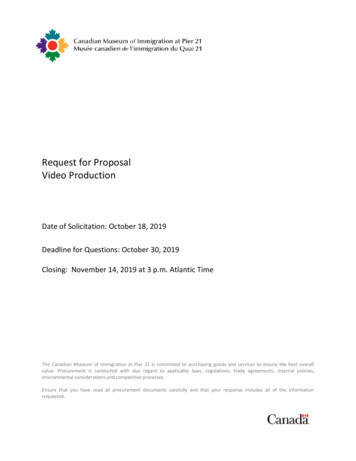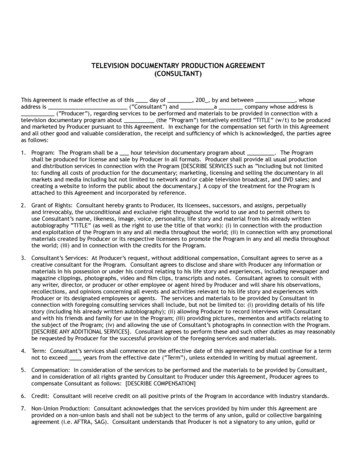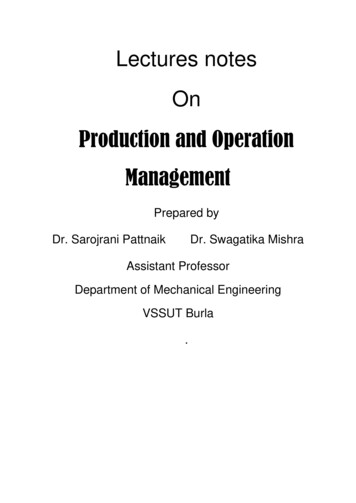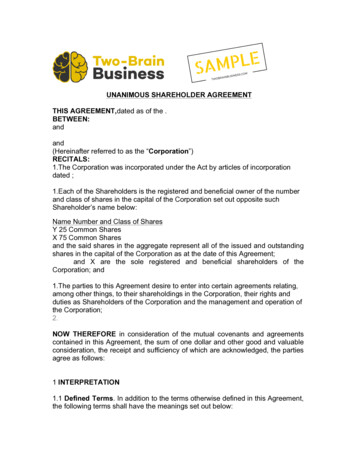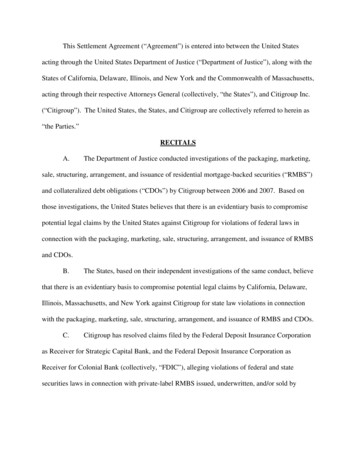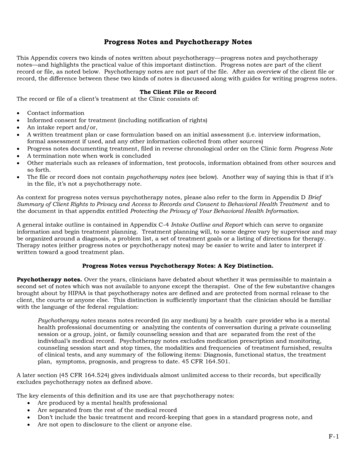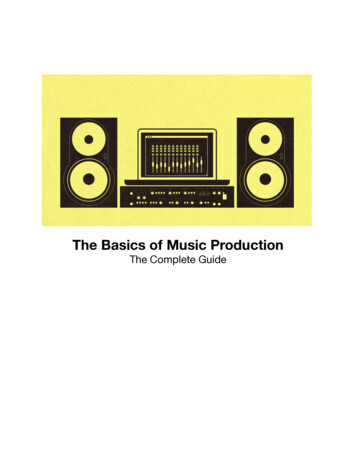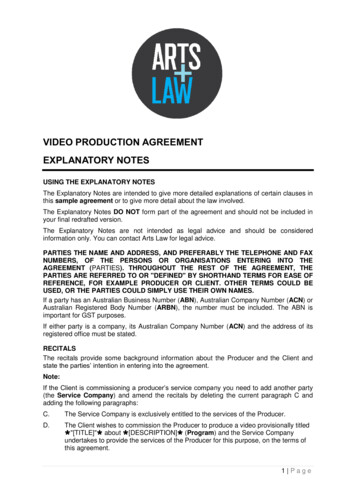
Transcription
VIDEO PRODUCTION AGREEMENTEXPLANATORY NOTESUSING THE EXPLANATORY NOTESThe Explanatory Notes are intended to give more detailed explanations of certain clauses inthis sample agreement or to give more detail about the law involved.The Explanatory Notes DO NOT form part of the agreement and should not be included inyour final redrafted version.The Explanatory Notes are not intended as legal advice and should be consideredinformation only. You can contact Arts Law for legal advice.PARTIES THE NAME AND ADDRESS, AND PREFERABLY THE TELEPHONE AND FAXNUMBERS, OF THE PERSONS OR ORGANISATIONS ENTERING INTO THEAGREEMENT (PARTIES). THROUGHOUT THE REST OF THE AGREEMENT, THEPARTIES ARE REFERRED TO OR "DEFINED" BY SHORTHAND TERMS FOR EASE OFREFERENCE, FOR EXAMPLE PRODUCER OR CLIENT. OTHER TERMS COULD BEUSED, OR THE PARTIES COULD SIMPLY USE THEIR OWN NAMES.If a party has an Australian Business Number (ABN), Australian Company Number (ACN) orAustralian Registered Body Number (ARBN), the number must be included. The ABN isimportant for GST purposes.If either party is a company, its Australian Company Number (ACN) and the address of itsregistered office must be stated.RECITALSThe recitals provide some background information about the Producer and the Client andstate the parties’ intention in entering into the agreement.Note:If the Client is commissioning a producer’s service company you need to add another party(the Service Company) and amend the recitals by deleting the current paragraph C andadding the following paragraphs:C.The Service Company is exclusively entitled to the services of the Producer.D.The Client wishes to commission the Producer to produce a video provisionally titled "[TITLE]" about [DESCRIPTION] (Program) and the Service Companyundertakes to provide the services of the Producer for this purpose, on the terms ofthis agreement.1 Page
PRODUCER’S OBLIGATIONS (CLAUSE 1)Compliance with the Brief: The Producer must comply with the Client’s brief (Brief) set outin Schedule A. If the Producer substantially complies with the Client’s requirements for theProgram, the Client must accept (and pay for) the video produced (see clauses 4.2 and 5.1).Accordingly, the Producer should ensure that the Client's requirements for the Program arespecified as fully as possible in the Brief.Production Schedule: The parties need to agree to a production schedule that sets realisticcompletion dates for each major stage of production, such as scripting, commencement ofprincipal photography, completion of principal photography, and off-line editing. TheProducer must comply with these deadlines unless circumstances beyond the Producer’sreasonable control delay production, or the parties agree in writing to alter the deadlines. Ifthe stages of production specified in Schedule B are inappropriate for your project, you needto replace them with other stages.Related Material: The Producer might also have to create material other than the actualProgram itself in relation to the agreement, such as artworks, set designs and soundtracks.The parties should list such material in Schedule C.Engagement of personnel: Under the agreement, the Producer is required to hire allpersonnel necessary to produce the Program. The Producer is responsible for obtainingsigned releases from all performers to cover all uses of their performance in the video, andto obtain an assignment of any copyright they may have in a sound recording. See ArtsLaw's information sheet Performers' rights and Arts Law's sample Performer’s Release formore information on performer's releases. Contact the Media Entertainment and ArtsAlliance for information on industry awards for performers (see Useful Organisations).The agreement assumes that the Producer is also the director of the Program. If anotherperson is to direct the Program, Arts Law's sample Producer and Director Agreement maybe useful.Responsibility for loss or damage: The Producer is responsible for all film productioninsurance. A good summary of insurance issues in film is set out in the chapter on insurancein Film Business – A Handbook for Producers, by Tom Jeffrey (see Further Reading).Other matters: If the Client wants the Producer to report to the Client about the Program’sproduction, the parties need to add another sub-clause to cover this.CLIENT’S OBLIGATIONS (CLAUSE 2)In addition to providing the Brief and being available for consultation (see clause 3), theClient may provide other material, personnel and services to assist the Program’sproduction. For example, the Client may have access to a celebrity sportsperson throughsponsorship agreements, whom the Client wishes to use in the Program. In the case of acommission to produce a music video, the Client would have to supply a high quality copy ofthe recording to the Producer in a format suitable for incorporation into the video; Bandmembers may also agree to make themself available to appear in the video. Suchcontributions should be listed in Schedule C.APPROVAL AND CONSULTATION (CLAUSE 3)The Producer is required to consult with the Client at the completion of each stage of theProduction Schedule and, in particular, to draw the Client’s attention to anything that couldmaterially affect the Program, such as expenses that were not foreseen and were therefore2 Page
not included in the Budget. The parties are also obliged to engage in good faith discussionsover any of these issues (see clause 3.4). In addition, the Client must be available to theProducer whenever the Producer reasonably requests.The parties should change clause 3 if they consider it too onerous.DELIVERY AND ACCEPTANCE OF THE PROGRAM (CLAUSE 4)The parties must specify in which form the Producer must deliver the completed Program tothe Client. If you are the Producer, think about the costs involved to meet your deliveryobligations, and whether the Budget covers them. Often, production companies will provideduplication and packaging services as part of the production "package". The parties shouldspecify in Schedule D in what format the master must be delivered. Usually, it will be insome digital media storage device, such as DVD or external hard-drive, or by electronictransmission.The Producer must deliver the materials specified in Schedule D by the Delivery Datespecified in Schedule B. If the Producer fails to deliver the materials by the Delivery Date,the Client may terminate the agreement under clause 12.2.Although the Client may choose not to use the Program (see clause 8.3), the Client mustaccept and pay for the Program if it has been produced in accordance with the Brief.PAYMENT (CLAUSE 5)Under the agreement, the Client pays the Producer in three instalments. The final instalmentis conditional on the Producer delivering the materials specified in Schedule D.Failure by the Client to pay the Producer within a certain period from the time specified inclause 5.1 entitles the Producer to terminate the agreement (clause 12.1).The parties should establish a detailed budget to include into Schedule E. The budgetshould outline all foreseeable costs of production of the Program, and should include any feepayable to the Producer. Refer to Screen Australia’s budgeting manual, The Satchel Production Budgeting & Film Management, for some guidance regarding production budgets(see Further Reading).As it is difficult to predict accurately all costs of video production, the Budget should includea contingency. Usually, the contingency is expressed as a percentage of the total budget.Clause 5.2 requires the Producer to seek the Client's approval before incurring any expensenot covered by the Budget.Sometimes production agreements require a producer to repay any money not spentproducing the Program. You need to insert a clause into this section of the agreement if thisis to occur. Conversely, the parties may want to deal with the possibility of a shortfall inmoney needed to produce the Program differently from the current clause 5.2. In this case,that clause should be changed.GOODS AND SERVICES TAX (CLAUSE 6)The parties to the agreement must consider their obligations with respect to taxation andother statutory fees and charges.GST is a general tax on goods and services supplied in Australia. Most supplies for artsbusinesses made for consideration (e.g. money or payment in kind) will be subject to GST.3 Page
Clause 6 provides that payments are exclusive of GST. If this does not suit your situation,you will need to consider an alternative clause.You should obtain specific professional advice on your GST and tax position andobligations under the agreement and generally.For more information contact the Australian Taxation Office on 13 28 66 or visit the websitewww.ato.gov.au. In addition, the Australia Council for the Arts has published Artefacts: theArts and Tax - a practical tax workbook for the arts sector which can be downloaded freefrom the Australia Council website.TITLE TO AND COPYRIGHT IN THE PROGRAM AND RELATED MATERIAL (CLAUSE 7)The parties need to decide how to distribute ownership of physical objects protected bycopyright, such as sets, excess footage, copies of scripts and artwork, after the Program iscompleted. Physical ownership of these objects is different from ownership of any copyrightin them, and it is possible for copyright and title to the physical objects to be held by differentpeople. The holder of title to the physical objects cannot reproduce, perform in public orcommunicate them to the public unless the holder also owns the copyright, or has a licence(i.e. the permission) of the copyright owner (or another licensee allowed to give thispermission) to do so.Under clauses 7.1 the Client has title to all tangible materials produced under theagreement.Under the Copyright Act, the person who commissions the making of a film against paymentof some remuneration to the producer owns the copyright in the film unless there is anagreement to the contrary. Clause 7.2 confirms the statutory position as to the Client’sownership of the copyright in relation to the Program and Related Material. The Clienttherefore has the right to: make copies of the Program; communicate the Program to thepublic (broadcast or make available on the internet); allow the Program to be seen in public(eg. as part of a store window display); and allow the Program to be transmitted on a privatedistribution service (eg. in-house hotel cable TV).The parties may modify the agreement so that copyright in the Program (including excessfootage) or Related Material is vested in the Producer, who grants the Client an exclusivelicence to use the Program (and other materials) in accordance with their intentions. Such aclause should be drafted by a lawyer with expertise in film contracts.Under clause 7.3, the Producer is responsible for paying the fees or royalties for the use ofthird parties' copyright material in the Program. For example, the Producer is responsible forpayment of all fees, royalties and other sums which may need to be paid for the use of: artwork; songs (including music and lyrics); sound recordings; and literary worksreproduced or used in the Program. Arts Law recommends including in the Budget anamount to cover the licensing expenses for the use of this material. Arts Law has a numberof sample licence agreements for the use of literary, dramatic or musical works in a film orvideo (see the other sample agreements in the Low Budget Film and Video Pack).4 Page
The Producer is, however, not responsible for paying any royalties for the publicperformance or communication of copyright material and performances of any copyrightmaterial included in the Program to collecting societies such as the Australasian PerformingRights Association (APRA) or the Phonographic Performance Company of Australia(PPCA) because these fees relate to the exploitation of the Program by the Client ratherthan to the Program’s production.CLIENT’S USE OF PRODUCER’S NAME AND LIKENESS, CHANGES TO THEPROGRAM (CLAUSE 8)Under clause 8.2 the Client may change the Program and any Related Material provided theClient informs the Producer of the proposed change. The Producer may not oppose thechanges but may elect to have his/her name removed from the credits.CREDITS (CLAUSE 9)Under clause 9 the Producer must be credited in the Program and on all copies of theProgram, as well as in all promotional material associated with the Program.Clause 9.4 requires the Client to ensure that distributors are obliged to conform to the creditprovisions of the agreement. Clause 9.6, however, protects the Client by limiting thecircumstances in which the Client will be liable for breach of the credit provisions.MORAL RIGHTS (CLAUSE 10)Moral rights are personal rights of an artist, provided for under Part IX of the Copyright Act1968 (Cth). They cannot be bought or assigned (i.e. sold). They belong to an artistregardless of whether the artist is still the copyright owner. Moral rights apply to artistic,literary, dramatic and musical works and films. They also exist for performers in liveperformances (so far as the performance consists of sounds) and sound recordings of thoselives performances.In Australia, there is no need to "assert" your moral rights. However, this is required in someother countries, including the United Kingdom and New Zealand. You should include aclause dealing with this if your work is likely to be sold or distributed in these countries.In Australia there are 3 moral rights, namely the right of a creator:1. to be named as the work’s author or creator (the right of attribution);2. not to have his/her work (falsely) attributed to another (the right against falseattribution); and3. to protect his/her work from unauthorised alteration, distortion or other derogatorytreatment that prejudices his/her honour and reputation (the right of integrity)."Derogatory treatment" in relation to an artistic work is defined in theCopyright Act as:"(a)the doing, in relation to the work, of a
Program, the Client must accept (and pay for) the video produced (see clauses 4.2 and 5.1). Accordingly, the Producer should ensure that the Client's requirements for the Program are specified as fully as possible in the Brief. Production Schedule: The parties need

